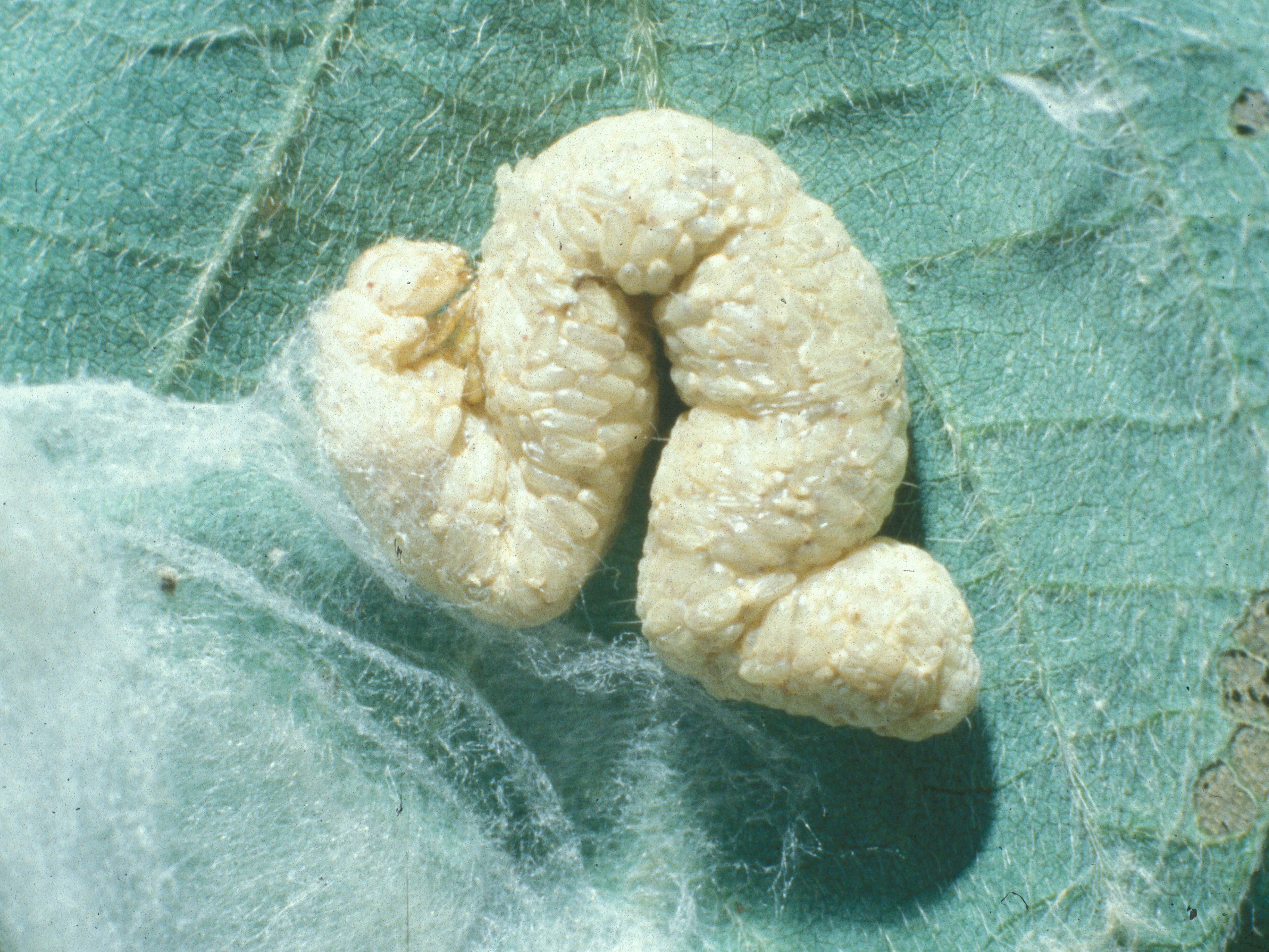Copidosoma Wasps, Vol. 10, No. 11
Copidosoma Wasps
Order: Encyrtidae
Family: Hymenoptera
 Thousands of tiny wasps all from a single egg? C. floridanum (Cf) is not the showiest insect ever discussed in Bug’s Eye View, but it is one of the most unusual.
Thousands of tiny wasps all from a single egg? C. floridanum (Cf) is not the showiest insect ever discussed in Bug’s Eye View, but it is one of the most unusual.
The photo shows a soybean looper caterpillar that died inside its cocoon. Look closer and you will see that the body of this caterpillar is filled with small oval objects that look like Rice Krispy puffs. These are empty cocoons of C. floridanum wasps. There were thousands of these tiny wasps, and they all developed from a single egg. One group of researchers reported 3055 Cf wasps developing from a single egg, and several other reports exceed 2500. The adult wasps are only about 1 mm long, which is why so many can fit inside the body of a looper caterpillar.
Cf wasps search for eggs of soybean and cabbage loopers, which are laid individually on undersides of leaves. Upon finding an egg they parasitize it with an egg of their own, which begins developing within the resulting caterpillar, dividing many times to produce the thousands of embryos mentioned above. But the parasite larvae don’t begin feeding and growing right away, which would result in early death of their host. Instead, they wait, in a suspended state, until the caterpillar is nearly grown. During this time, they produce compounds that cause parasitized caterpillars to live longer, eat more, and grow larger than normal—up to half again as large, resulting in more food and room for the parasites. Once the caterpillar is ready to pupate, the parasites begin feeding and growing, ultimately killing the caterpillar inside its cocoon, and filling its body with thousands of Cf cocoons.
That’s a strange life cycle, but it is even stranger than this. Cf wasps that develop from fertilized eggs are female, while wasps developing from unfertilized eggs are male. Cf wasps can reproduce without mating, with all progeny being male, but Cf wasps that have mated can lay either a fertilized female egg or an unfertilized male egg, each of which will multiply as described above, producing same sex clones. When they parasitize a looper egg, Cf wasps only deposit one or two eggs, and in the case of two eggs, one will usually be female and the other male.
There’s another even more unusual twist to the biology of these tiny wasps. Not all the embryos developing from the initial egg remain in delayed development until the caterpillar host is mature. Some hatch early, as special, “soldier larvae” that will not survive to become adults. Their job is to patrol inside the body of the host caterpillar and destroy any other parasites that are attempting to take over “their caterpillar,” eliminating the competition. Although these soldier larvae do not live to reproduce, they increase the chances their sisters or brothers will. Looper caterpillars are hosts for many other parasitic wasps, most of which develop earlier in the life of their host, and this earlier development would give them an advantage over the Cf wasps—except for those Cf soldier larvae.
You will probably never spot a Copidosoma floridanum wasp in your garden; they are just too small to notice. But you might one day find a parasitized looper mummy on the underside of a butterbean or cabbage leaf. If you do, put it in a jar and see how many wasps emerge. If you are feeling ambitious, you can even try to count them.
For additional information see: The Largest Parasitoid Brood, Juan Alvarez, 1997 and Copidosoma floridanum, Parasite of the Day, by D. O'Leary, 2018.
Blake Layton, Extension Entomology Specialist, Mississippi State University Extension Service.
The information given here is for educational purposes only. Always read and follow current label directions. Specific commercial products are mentioned as examples only and reference to specific products or trade names is made with the understanding that no discrimination is intended to other products that may also be suitable and appropriately labeled.
Bug’s Eye View is now on Facebook. Join the Bug's Eye View Facebook group here.

